
 |
|
|||
|
evaluation
hi fellas,
at the request of our local varsity assignor i did an evaluation for him on a guy he hadn't seen work yet. i posted it on another site and it has some good discussion going on. my question to y'all is, would you like me to bring it over here as well for those of you that don't frequent multiple sites? if there's any interest i'd be happy to do so.
__________________
"To dee chowers!!" |
|
|||
|
Ah so you = squeaky.
I think it would be a good tool to see here. I have enjoyed reading it on the other site.
__________________
Even if you’re on the right track, you’ll get run over if you just sit there. - Will Rogers |
|
|||
|
I saw it over there. I thought it was very indepth and worded in a way that would not put him on the defensive. I hope it helps him
__________________
Once in awhile you can get shown the light, in the strangest of places if you look at it right |
|
|||
|
part 1
In 2 parts due to length restrictions...
Uniform and equipment The 2-tone ball bag is unappealing and outdated. It was a fad of at least 5 years ago. Please look into replacing it with a solid blue bag. I know it’s pricey, but please seriously consider purchasing a pair of steel-toed plate shoes. Getting hit in that game using improper/outdated equipment is a good example of what happens if you aren’t wearing what you are supposed to be when working the plate. There are numerous options available. If you do get a pair, make certain they are steel toed and not hard toed. That leads in to the chest protector, which we discussed after the game. There have been significant upgrades in technology since that thing was made. The West Vest Platinum and the Honigs K1 are the top of the line. They are more expensive than other options, but are well worth the money for the protection they afford. The belt you wear with umpire pants should fit the size of your belt loops. It will keep your ball bag open better and prevent you from struggling to get into it as I saw you did numerous times during the game. The loops on your pants accommodate a belt of 1 ¾ inch thickness. Honigs apparently only offers the non-patent leather one. Gerry Davis has a patent leather one if you like the shiny look. The jacket you were wearing will be acceptable only through the end of this season. Next year the MBUA will be requiring the shoulder stripe style pullover (Model K-17 through Honigs). Also, your current jacket should have a MBUA patch on it. Look into upgrading your plate pants. All plate pants now come with “saddle stitching” in the seat of the pants for reinforcement. They also have a lot more room than the ones you were wearing. I would recommend the darker grey poly-wool pants from Honigs. They are a little more expensive than others, but are more durable, higher quality, longer lasting, and better looking than the alternatives. These are the pants that all the Minor League guys are wearing (we have to pay extra to upgrade from the ones they issue us, but we do it because they are just plain better pants.) Strike mechanic We talked about this after the game. Work on “marrying” your verbal and visual mechanics. Also, try to eliminate the opening of your hand after calling a strike. Keep your fist closed throughout the mechanic. Foul tip mechanic As we talked about, if you are going to continue calling the foul tip, reverse the order that you currently use so you are signaling the foul tip first, followed by the strike mechanic. The mechanics themselves were fine, just backwards. Plate stance As we talked about, you do an excellent job of keeping your head still when seeing pitches. Work on tracking the pitch all the way from the pitcher’s hand into the mitt. We talked about quick timing which results from “tunnel vision,” meaning your eyes are not tracking the ball the last couple of feet before it enters the mitt. I thought your strike zone was well-sized and consistent throughout the game. Experiment with setting up on the inside edge of the plate and only adjusting your stance up if you get crowded like we did by your car. After a couple of games you should start to get a better feel for the outside part of the strike zone. Call every pitch to help with your timing, even the ones that aren’t close. Balls should be audible to the dugouts, strikes to the stands. Continue to increase the intensity of the ball call like you do when the pitches are close. If you are going to continue to work as far back as you are from the catcher, your head height needs to be a little bit higher than the top of the catcher’s head so you are able to see the low-outside pitch. Work on making adjustments to your head height by widening your base and increasing your amount of squat, which will lessen the amount of torso lean you currently use. As I said, your current stance has too much torso lean. That is not allowing your chest protector to properly protect you from getting hit as your shoulders are very much exposed. You absolutely must put the ball back in play when there is a dead ball and there are runners on base. We talked about this and I used the example of the pitcher throwing to first base in a pick-off attempt when you hadn’t put the ball in play. Eliminate all doubt. When the pitcher is on the rubber with the ball, the batter is in the box and the catcher is in position, put it back in play. You do not need to do this with no runners on base, or at the start of each inning. As we talked about, there is no “ball’s down” mechanic in communicating with your partner. The only thing you should be telling him is when the ball is caught. If he doesn’t hear, “That’s a catch,” then he knows the ball is down. That’s a good lead in to the next point; you do not need to verbally or visually signal an out on a routine catch. If everyone in the ballpark knows the kid caught it simply communicate to your partner, “Catch, Bill.” Your pre-play communication with your partner was erratic. Sometimes you did, sometimes you didn’t. The simpler, the better with these signals, but it is important to use them before the at bat starts or when the situation changes during an at bat to remind both you and your partner of your responsibilities. There is no need to call time to sweep the plate. Wait for the action to stop, then get in and get out. The fewer times you have to call time throughout the course of a game, the better. Move your feet between pitches. You stayed in the same spot as if you had dropped anchor there. After you call the pitch, stand up and move around a little bit while the pitcher is getting back up on the mound. When he gets up there, then you can go ahead and step back in behind the catcher. This will keep your legs looser and also not give you the anchored appearance. Plate mechanics Work on slowing down your called strike three mechanic. If you want to use the “chainsaw” like you used, try doing it almost as two separate mechanics; throw the fist forward and call “strike” then, while standing up, pull the cord back and call “three.” This will allow you to be more under control and will allow you to stand up and use your height to your advantage. As we talked about, remove the “ring up” mechanic on swinging strike three. Everyone in the park knows he just swung and missed. Ringing him up is sticking it up his rear end and is unnecessary. Try to eliminate “dead ball” from your signaling. Simply call, “Time.” Also eliminate all of the extra pointing you do: -There is no need to point to 1B on a base on balls. It could easily be misconstrued to be either a strike call or a half-swing appeal. Simply say “ball four” and let the kid go on his way. - There is no need to point to your partner before the start of each half inning. Take a glance down and make sure he’s there and paying attention, then go ahead and start. The point is a lower level mechanic (little league) and isn’t used in higher levels of baseball. - A couple of times you pointed at the plate when runners crossed it. That is unnecessary and could be considered coaching.
__________________
"To dee chowers!!" |
|
|||
|
part 2
Coverage and rotations
On ground balls in the infield with no runners on, you did a good job of getting out from behind the plate, but you need to be on the line instead of inside like you were. Clear the catcher to the left then get back on the line and get up as far as the play will allow and make sure you are set as the play happens. As we discussed, a good time to start shutting it down is when the fielder has secured the ball and is about to release it. This will allow you ample time to be sure you are not moving when the play is happening. 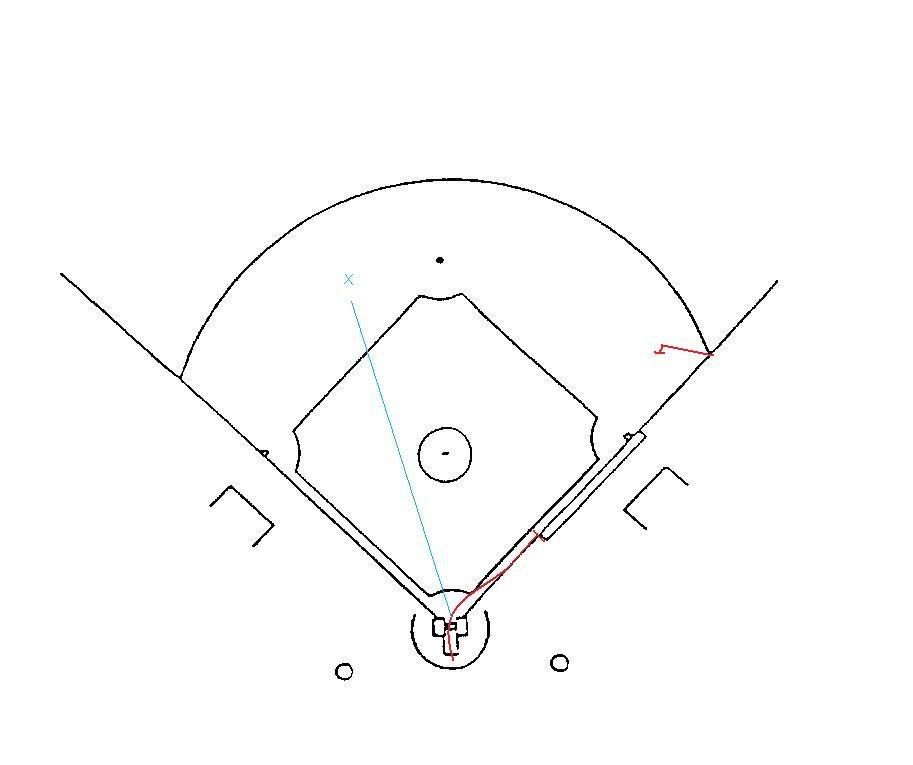 As we discussed, work on getting a better position for plays at the plate. Start at the point of the plate and then read the play as it develops. If it is going to be a swipe tag play then the best position to see this from is on the 3rd base line extended. If it is going to be a collision/plate blocking play then the best position is on the first base line extended. Starting at the point of the plate will allow you to adjust either way as the play develops.  With a runner on 2b only, your only movement on a base hit is to get into position for a pay at the plate. You sometimes started for third base in this situation. Simply take a couple of steps to get to the point of the plate so you can then make the necessary adjustment should a play at the plate develop. On fly balls/base hits to the right side of the outfield with no runners on base you did a good job of getting out from behind the plate, but you did not go in the right direction, and did not get enough distance. When you bust out from behind the catcher you have two possible responsibilities: the ball if your partner does not go out; or the runner if he does. In either instance, you are headed in the same direction…the direction of the ball. If it is your ball, bust out in the direction of the ball and get as much distance as the play will allow you to, making sure you are set for the play. If your partner goes out, then you are still headed out in the direction of the ball as you are reading that your partner has gone out. When he does go out, continue out in this direction and then stay ahead of the runner and take him to 2B or back into 1B.  You did a good job a couple of times realizing that you had fair/foul responsibilities. When you do have to call a fair/foul, you must be on the line to make a call. If you are off of the line your angle is skewed and you will not be believable. You did a good job realizing you had a 1st to 3rd responsibility and did a good job communicating to your partner that you were moving. As soon as you read there will be no play at 3rd, head back to the plate and also communicate this to your partner, “I’m going home.” You had a situation where there was R1 and a deep fly ball to left. You took a couple of steps out from behind the plate toward 3B and stopped. In this situation, keep moving toward 3B until the ball is either caught or falls in. You should keep moving in that direction because if it does fall your next responsibility is R1 into 3B and you will already be heading there instead of reacting late. If it falls tell your partner you’ve got third, if it is caught, retreat to the plate. On fly balls to the left side of the outfield with no runners on base you can get more distance for the play than you were getting. Bust out from behind the catcher and get as much distance as the play will allow, making sure you are set for the play. 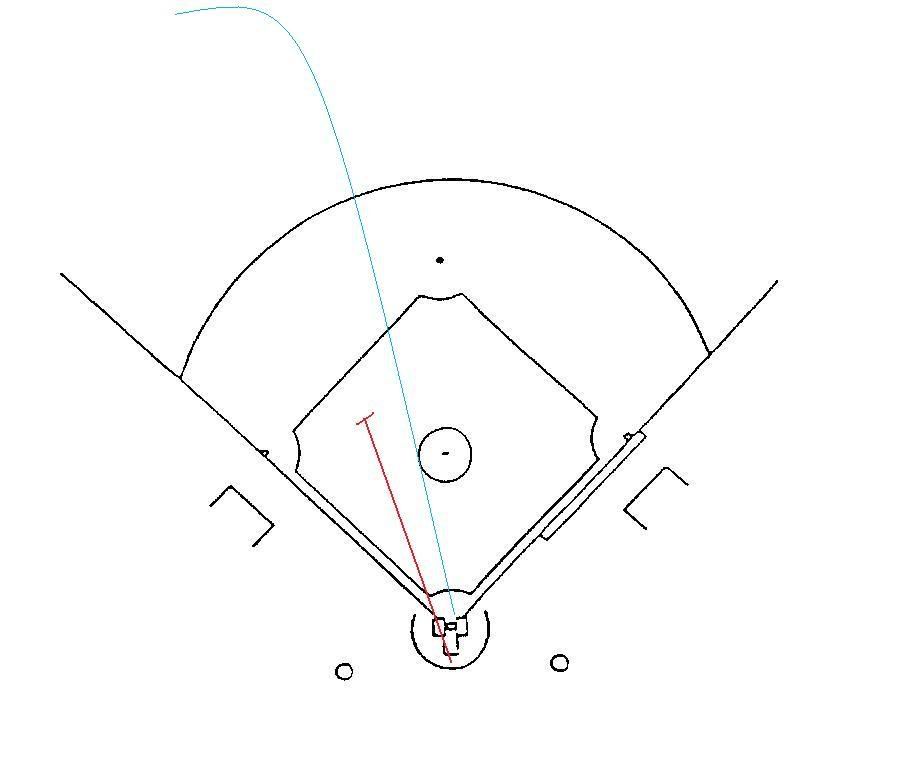 With R1 only you had a deep fly ball to right that took the right fielder toward the line a step or two. If you are going to take this ball then you must tell your partner you are taking it, and then you must get distance toward the play. You ended up calling the catch from the first base line extended and never communicated to your partner that you were taking it. You have to communicate this because if you are taking the ball then you will not be taking R1 into 3B if it falls in for a hit and your partner needs to be aware of that so he can adjust. If you do take responsibility for the ball you can get some distance up the 1B line because your next responsibility is going to be a play at the plate if the ball drops. You have given up 1st to 3rd resp. to your partner so the play will allow you to be a little farther up the line. 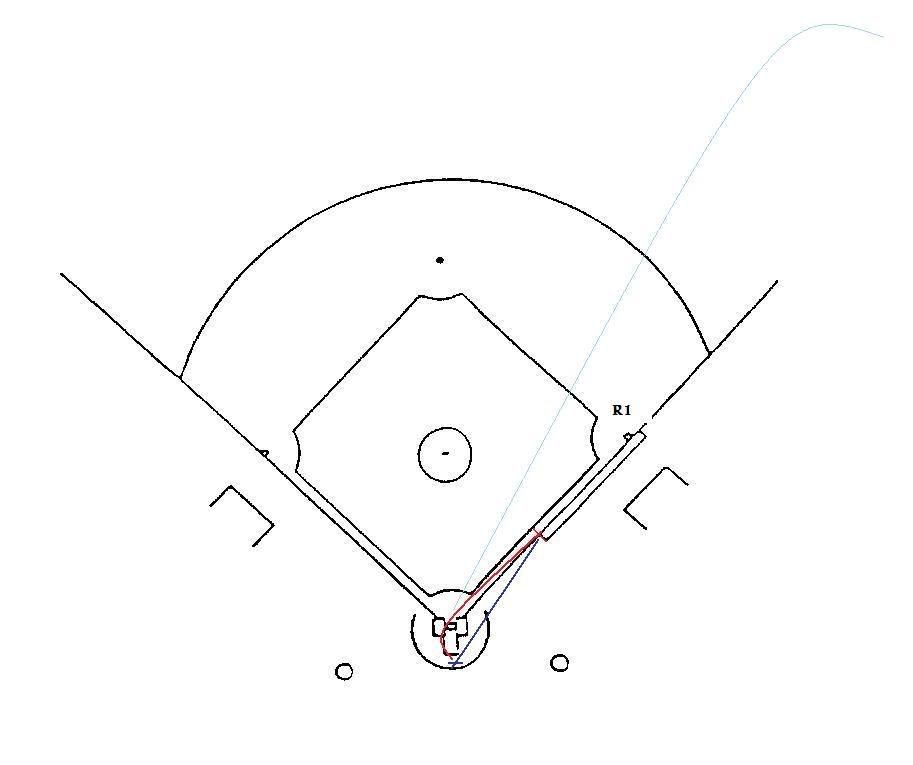 On fly balls in the infield you can get a little more distance than you were getting. Get out in front of the plate in the direction of the ball, again only going as far as the play will allow. Likely this will put you about halfway between the dirt of the mound and the dirt circle of the plate area. You did a good job reacting to your partner staying on the line for the fly ball to the 1st baseman. As we talked about, he should have gone inside on that ball. When he didn’t, somebody had to be responsible for the runner if the ball dropped, and you were in position to do that as you had come inside. You have to make sure you react to your partner going out on a ball with no runners on. You got lucky because the ball landed foul. Had it landed fair there’s no way you were going to be able to get to 2B in time for a play because you had not moved. Like we talked about, your partner did not help you out much because he should have gone out on a couple of balls that he didn’t, however, this one I’m talking about he immediately turned his back to you to watch the ball which is an automatic signal that he is out on the play and you now have the runner. You did an outstanding job of letting the catcher take you to the ball on the foul pop up. Work on the half swing appeal mechanic so it looks crisp. Call the pitch first, and then indicate that he didn’t swing, “Ball, no he didn’t.” Then, if somebody asks for an appeal, step out from behind the plate and take a step toward your partner and loudly ask him, “Did he go?” while pointing with your left arm (so it can not be confused with the pointing of a strike.) closing remarks edited out
__________________
"To dee chowers!!" |
|
|||
|
the following was in response to somebody that asked for more information about being on the 1bL extended from my eval.
i gather from your post that you are a scholar of the "put the bag between you and the ball" theory, correct? i, too, am in that school, but it isn't often feasible to practice this when using the 2 man system. the only reasonable times this theory can be practiced is the PU covering 3B, the BU calling a play on his only runner at 2B with the ball coming from the vicinity of CF, and, sometimes, the PU taking plays at the plate. in just about all other scenarios, positioning yourself using this theory would likely leave a significant portion of the field uncovered. that being said, let's move on to your inquiry. you asked me to elaborate on the 1B line extended from my OP in regard to plays at the plate. notice i said "sometimes" about plays at the plate. sometimes that is going to be the best place to be, but other times it will not. as this post progresses you will (hopefully) see the point i'm trying to get across is the absolute need to read and react in order to get in the best possible position to see the pay. i'm going to throw a couple of pictures and a drawing in to try and use as tools for explaining. i hope they are helpful. my suggestion after the eval, and to all those that i train or that ask for help, is to start at the point of the plate and adjust as the play dictates. as a general rule, on throws originating from RCF to the RF line (area shown in orange in the diagram), the resulting play at the plate (if it is close) is probably going to be a swipe tag type of play. on throws originating from the other 2/3 of the outfield (shown in green in the diagram, the resulting play at the plate will probably be a plate blocking or collision type of play. if you notice my wording both in this post and in the eval, i said "likely" and "probably" when saying what type of play will develop. nothing is ever certain, and you HAVE to read the play and make adjustments for what type of play will develop. 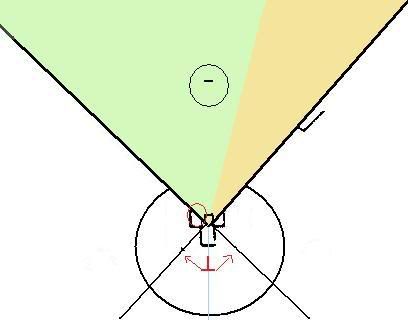 now, on to the positioning...for the most part, the best angle to see a swipe tag type of play is to be looking up somewhere in the vicinity of the 3rd base line extended toward the plate as the catcher will be lunging with the glove extended and the runner will be sliding to the outside with his hand extended back toward the plate. in that case, i want to be looking up the line at the gap created between the two players, which should have the plate centered right in the middle. on the flip side of that are plays where the catcher will have the plate blocked and will be waiting for the runner, or the ball and runner will arrive at approximately the same time and the throw is on line and the catcher is set up in a position to block the plate once he has the ball. in these types of plays the probable best position is going to be close to the first base line extended because that will afford me a view of the tag, and a view of the plate to see if the runner happens to sneak a foot through. if you are on the third base line extended for this type of play you can probably see the plate between the catcher's legs if he is blocking it, but you will not be able to see the tag because the catcher's body will be screening you out. see the following pictures for examples of where the first base line extended (or close to it) would be the ideal position. i have added a little color into the pictures to highlight the important areas that we must see as umpires. the arrows depict the view i'd like to have, and the circles indicate the action i need to see. again, i'm not saying by any stretch, "on some plays you have to be here and others you have to be there." these types of plays require a little bit of umpiring. simply stated, you MUST be able to read what is developing and react to it to try and put yourself in the best possible position to see the play.   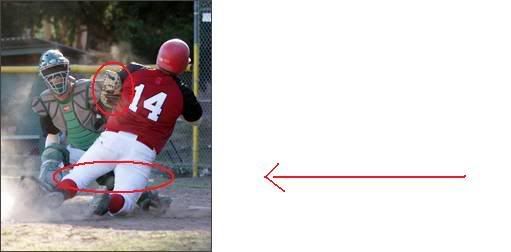 we all know about this play. as it turned out, 3BL extended was probably the best place to be for this play. the picture, however, is a good photo of what i am looking for as far as action on a play. a good example of the absolute necessity of being able to read and react to the play. 
__________________
"To dee chowers!!" |
|
|||
|
TC,
That last post on "point of the plate" to 1BLX or 3BLX for positioning on plays at the plate is about the best description of the principles I've ever come across. Kudos. Also, nice job on the evaluation. My association has a "voluntary" evaluation program. If you want to paticipate, you sign up for it and pay less than half a game fee. Two of the senior guys come out and watch two different games (one at each) and write up an evaluation modeled on the NCAA evaluation form. I signed up last year, and it was probably the best ROI I've had on an investment in my brief umpiring career. Like yours, the write-ups were very thorough, specific, and comprehensive (well, OK, I didn't get any pictures with mine) - and incredibly helpful. Also, like yours, they weren't "sugar coated" - but, you should have a thick skin if you want to umpire. JM P.S. I concur with DG's observation as well.
__________________
Finally, be courteous, impartial and firm, and so compel respect from all. Last edited by UmpJM; Fri Apr 18, 2008 at 12:24am. |
|
|||
|
Nice job, Bobby! Our association has a service where an umpire makes a request to one of our officials who is retired MiLB. He will do a professional observation and assessment along with a DVD of the official's entire game. The cost is one half of your game fee.
Like your's, the assessment is a "here it is" with no sugar coating. The requesting official is forewarned that he better be prepared for a "real" evaluation at the end and not take anything personally. Oh, and the official has no idea when the observer will be there. I found out that several of our newer officials have already had theirs done and they love it. Any association can benefit by having observers. Officials sometimes cannot see their flaws and really end up becoming better officials when they sit and talk with a veteran that is interested in making better officials. Having a DVD to watch is even better! You never realize what you are doing until you see for yourself! Damn, is my gut really that big? 
__________________
When in doubt, bang 'em out! Ozzy |
|
|||
|
Quote:
__________________
"To dee chowers!!" |
|
|||
|
Quote:
I do see how it could be beneficial to the paid side as well. I'm simply appreciative that it was not placed under lock and key initially. |
|
|||
|
[QUOTE=bobbybanaduck]In 2 parts due to length restrictions...
Uniform and equipment Bobby good evaluation My question? Did this umpire accept your evaluation graciously or did he get on the "defensive" when you went over these topics? Thanks Pete Booth
__________________
Peter M. Booth |
|
|||
|
this is the email he sent after i emailed him the eval:
The attachment opened up fine. Thank you for the links and for the time to put diagrams into your report. It really made a difference. I appreciate your advice and have been working on them to make them second nature. It was great to be able to talk to you and get a knowledgeable answer in return. I am sure that I will be taking you up on your offer for advice as the season progresses. Thanks again for the advice and for taking the time to put together a comprehensive report. after the game while we were talking at his car he was open to anything i had to say and was very receptive. his friend, a former AAA umpire, got him into umpiring a few years ago and had given him some tips, but, he had never had any sort of training outside of the initial rules clinic, test, and required field sessions.
__________________
"To dee chowers!!" |
 |
| Bookmarks |
|
|
 Similar Threads
Similar Threads
|
||||
| Thread | Thread Starter | Forum | Replies | Last Post |
| Evaluation Help | PIAA REF | Basketball | 8 | Fri Dec 02, 2005 08:26pm |
| Training and Evaluation | jumpmaster | Baseball | 3 | Mon May 17, 2004 06:20pm |
| My first formal evaluation | rainmaker | Basketball | 14 | Tue Dec 23, 2003 09:55am |
| Evaluation of Officials | DownTownTonyBrown | Basketball | 2 | Wed Oct 29, 2003 08:10pm |
| First Evaluation | Mike Burns | Basketball | 16 | Wed Feb 19, 2003 03:11pm |